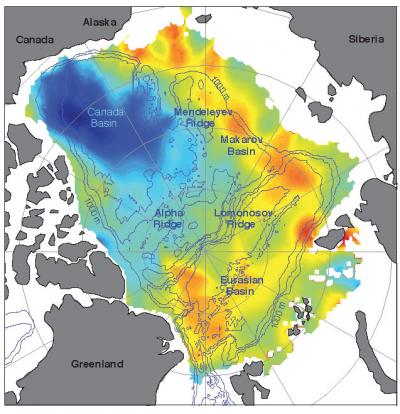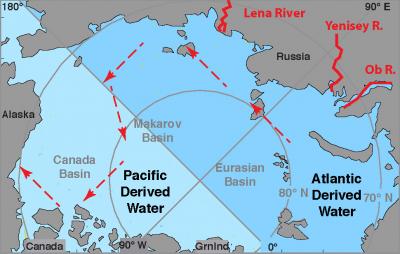Arctic Freshwater Surge Caused by Rivers, Not Ice, Study Says


A dramatic rise in fresh water in the Arctic's Beaufort Sea was primarily caused not by melting ice but by a 20-year-long shift in atmospheric pressure that altered the output of three mighty Russian rivers, a new study finds.
Frigid water flowing from the Ob, Lena and Yenisey rivers into the Arctic Ocean was diverted hundreds of miles to a completely different part of the ocean in response to the pressure shift, which was associated with a phenomenon called the Arctic Oscillation. The influx was like adding 10 feet (3 meters) of fresh water over the central part of the Beaufort Sea.
Understanding where fresh water comes from, how much of it there is, and where it goes helps scientists understand the forces at work in the Arctic and how they might change in a warming world.
"Knowing the pathways of fresh water in the upper ocean is important to understanding global climate because of fresh water's role in protecting sea ice— it can help create a barrier between the ice and warmer ocean water below — and its role in global ocean circulation. Too much fresh water exiting the Arctic would inhibit the interplay of cold water from the poles and warm water from the tropics," said study author Jamie Morison, an oceanographer with the University of Washington's Applied Physics Laboratory.
Pressure patterns
While the salinity (or salt content)of the Arctic Ocean as a whole hasn't changed much, the Beaufort Sea, on the Canadian side of the Arctic, is the freshest it's been in 50 years of record keeping, said co-author Ron Kwok, senior research scientist with the Jet Propulsion Laboratory in Pasadena, Calif.
The Beaufort Sea stores a significant amount of fresh water from a number of sources, especially when an atmospheric condition known as the Beaufort High causes winds to spin the water clockwise in a swirl known as a gyre. When the winds are weaker or spinning in the opposite direction, fresh water is released back into the rest of the Arctic Ocean, and from there to the world's other oceans.
Get the world’s most fascinating discoveries delivered straight to your inbox.
Some scientists have said a strengthening of the Beaufort High is the primary cause of freshening, but the new study, using NASA satellite data, shows that salinity began to decline in the early 1990s, a time when the Beaufort High was not as pronounced. At the same time, however, the Arctic Oscillation increased.
The Arctic Oscillation is always present and fluctuates between positive and negative phases. The negative phase features a high-pressure system over the Arctic and pushes cold air into the United States from Canada. The positive phase features a low- pressure system over the Arctic and wetter weather over Alaska, Scandinavia and other high-latitude places.
The new study shows that from 2005 to 2008, the Arctic Oscillation was in a positive phase, putting a low-pressure system in place that drew Russian river water away from the Eurasian Basin between Russia and Greenland and into the Beaufort Sea.
"We discovered a pathway that allows fresh water to feed the Beaufort gyre," Kwok said. "The Beaufort High is important, but so are the broader-scale effects of the Arctic Oscillation."
Morison, Kwok and their colleagues argue that the Arctic Oscillation has been in its current state for 20 years. For example, the changes detected in response to the Arctic Oscillation between 2005 and 2008 are very similar to freshening seen in the early 1990s, Morison said.
Ice impact
The freshwater content of the Arctic waters is of concern because of its connection to sea ice melt, which has increased substantially in recent decades, resulting in record-low areas of sea ice coverage in the region.
"Changes in the volume and extent of Arctic sea ice in recent years have focused attention on the impacts of melting ice," Kwok said.
The new findings, detailed in the Jan. 5 issue of the journal Nature, show that only a tiny fraction of the freshwater increase in the Beaufort is from melting ice and the vast majority is Eurasian river water.
In turn, this can have an impact on the ice in the Eurasian Basin: Less fresh water enters what is called the cold halocline, which normally sits like a barrier between ice and warm water that comes into the Arctic from the Atlantic Ocean. Without salt, the icy cold fresh water is lighter, which is why it is able to float over the warm water. Saltier water is more likely to sink, leaving ice more exposed to the warmer water and therefore making it more likely to melt.
In the coming years, if the Arctic Oscillation stops perpetuating that low pressure, the freshwater pathway should switch back, with fresh water once again insulating the ice of the Eurasian Basin.




